Contents
How to mix kick and bass
The low end is a tricky subject to nail down! The main characters of the low end are the kick and the bass. Getting them friendly takes a lot of iterations especially for the beginners. Once you have a good grip of the mechanism of the kick and bass, it gets a lot easier to handle.
What makes them challenging to mix is because they both are of the same power and don’t blend with other sounds of similar nature. So the question is, how to mix the kick and bass?
I have 11 best tips for you to get your kick and bass work well with each other everytime –
- Kick selection.
- Kick tuned to the track.
- Bass sound selection.
- Listening environment.
- Note placement.
- EQing kick and bass.
- Sidechain Compression.
- Keep them mono.
- Buss the kick and bass to a single channel.
- Use multiband compression.
- Saturate the low end.
These tips pretty much cover all the issues that may occur in most of your production. So let’s look at them in detail..
Before we start, let me introduce you to our –
Make sure to check it out.
1. Kick selection
The most important kick and bass mixing move you can make is to select the right kick sample for the track. Doing this will also make it easier to compliment the bass.
The right kick sample depends on two things – the genre and the bass sound!
For example, in the EDM genre, the kicks are heavy and really punchy and snappy to cut through the mix.
They are supposed to pound your chest in the clubs or make you move with every hit.

Kicks Type
The hip hop and trap has mostly the 808s or really subby kicks with a lot of heavy low end but there is a less amount of snap or high end to them.
Once a good kick sample is selected according to the genre, it will get easier to adjust it with the bass and the low end will be easy to mix as a whole.
2. Kick tuned to the track
Another important aspect of a good kick and bass mix is to choose a kick that is tuned to the key of the track.
This is not a requirement but it does help to make it fit with the bass very well.
The bass is obviously a musical instrument hence, when the kick shares the same space with the bass, it is more likely that both will blend together.
The low end has extremely powerful frequencies. It’s not a cakewalk to slap sounds in that region mindlessly.
Since the waveforms are bigger in length as compared to the upper range, they move a lot of air that are not easily ignored by our ears and so it takes a lot of care and attention in what you put there.
The powerful frequencies affect each other very much (if there are multiple) and any conflict can be heard very prominently in the track.
A tuned kick sound has a little chance to get along with another powerful sound which is the bass.
3. Bass sound selection
The bass sound selection is also equally important when it comes to mixing kick and bass successfully.
In terms of the sound envelop, there are different types of basses in the first place and require different choices for mixing.
The bass can be in the form of bass guitar, synth bass, sustained bass, plucked bass etc..
Each of them may have different envelops and thus establish different kind of relationship with the kick. For example a more sustained bass will require the kick to be shorter and vice versa.
There’s also a lot of variety in terms of the bass sound.
Bass can be pure sine wave with no harmonics, a bass that is more prominent in the low mids, a bass that has a rich top layer above it etc.

Bass Types
All these blend slightly differently with the kicks so the mixing depends on the type of basses all the time.
4. Listening environment
The key to mixing the kick and bass perfectly is to mix them in a perfect environment!
You can never mix the kick and the bass perfectly in a poorly treated environment on a poor monitor system.
The bass frequencies are very powerful and the biggest issue with them is that they buildup in a poorly treated room or they don’t even come out that accurately from poor monitors!
To deal with this issue, you need to get a good pair of flat response monitors so that they can reproduce the low end accurately without any coloring.
Next, you need to treat the room keeping the low frequencies in mind.
There is a difference in how the low, the mid and the high frequencies travel through air. The absorbent material for all the three frequencies also comes having different capabilities.
All the three frequency blocks need different grade absorbent materials or diffusers.
Good quality bass traps are good means to control the bass frequencies in a room.
The placement of the speakers need to be directed to your ears with their heights at your ear level so that the sound reaches directly in your ears instead of they reflect from the walls and then you hear them.
5. Note placement
After the bass sounds and the kick sounds are understood, now it’s time to take the note placement of the bass into consideration.
If the bass is playing when the kick is not, it makes things much easier. They pretty much get self mixed.
The opposite of this makes it a little tricky to fit the kick and bass together in a balanced way.
As you know the low frequencies are less forgiving in nature, they want their own space and are ready for a conflict always.
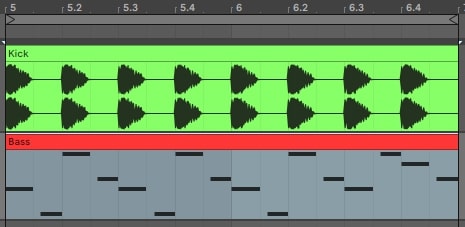
Kick and Bass Note Placement
The trick is to plan the note placement of the bass ahead, according to the kick or vice versa (whatever suits the groove) keeping the above scenario in mind.
If the track doesn’t allow choosing the note placement according to you, then there are methods that are discussed in the following sections.
6. EQing kick and bass
Well if the kick and bass are not self mixed, then we have always at our disposal, the equalizer.
- Before everything else, cut everything below 30 Hz. That region is non musical!

Low Cut
Now, the first step is to detect the conflicting frequency between the bass and the kick.
You can use a spectrum analyzer and check for that area where the two are fighting.
Now in the bass, find that region and cut a couple of dBs or a dB more till both of them fit well together.
Keep the bandwidth very narrow!
If you don’t have a spectrum analyzer, you need to sweep the frequencies in the bass by taking a bell curve and raising its gain to a good loud amount, with the kick and bass playing together.
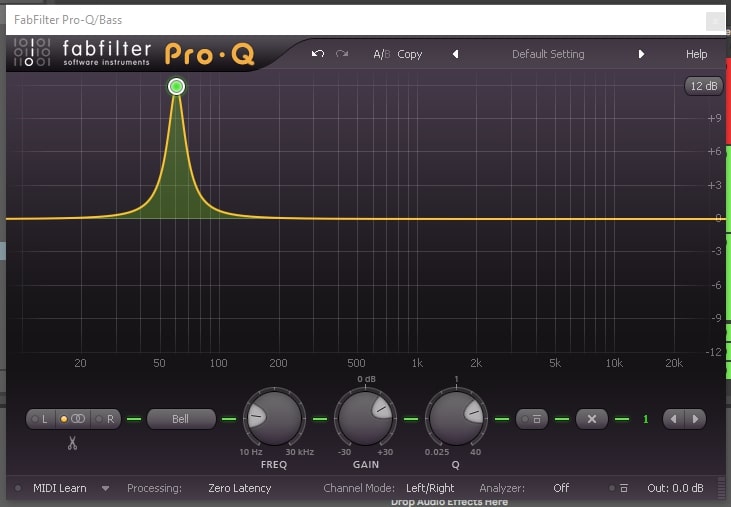
EQ Sweep
There will be a spot where you will hear a little artifact or distortion in the kick which will tell you that this is the exact frequency you need to cut.
Now reduce it from the bass till everything sounds clear.
And you now have a hole carved out for the kick to fit in and the kick now has retained its weight.
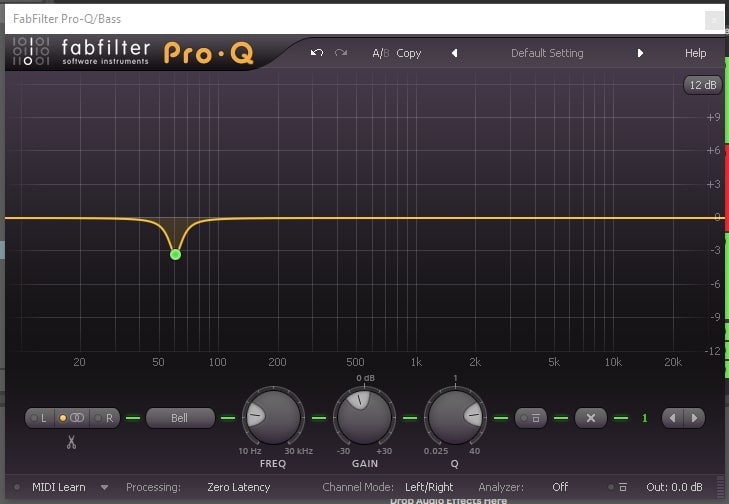
EQ Cut
A good thing to realize is that, the kick always hits at a same frequency spot whatsoever. So it’s wise to give it it’s place because its fundamental only takes a tiny spot in the low end rather than trying to adjust the kick for the bass.
There still can be situation where mere equalizer may not be enough.
For that the next trick comes into picture.
7. Sidechain compression
Sidechain Compression is used when all else fails. It’s also used for rhythmic purpose now a days in the EDM, trap etc.
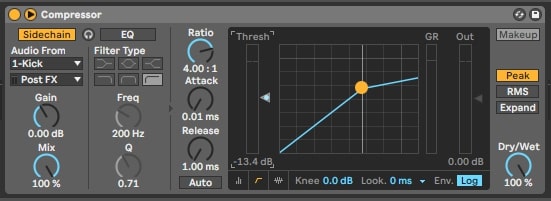
Sidechain Compression
Sidechain compression allows the kick to have its space along with the bass playing with it by ducking the bass down everytime it hits.
The sidechain compressor is triggered by the kick everytime it hits.
With this it affects the bass to lower in gain allowing the kick to stay prominent over the bass.
The sidechain compressor is used on the bass track.
Sidechain compressor works by taking the input from one track as its trigger and applies compression on the track on which it’s used. Here the kick track is the trigger and it applies compression on the bass track.
8. Keep them mono
The sub frequencies below 60 Hz are very powerful and they move the speaker cones with most power thus a lot of air gets moved.
The direction of such low frequencies are not detectable by our ears because they spread everywhere.
This tells us that there is no point in making them wider.
Making the low frequencies wider even presents a detrimental issue of phase cancelation –
Widening an originally mono sound creates a slight time difference in its left and right parts. As a result, opposite polarity may occur between the two and these left and right waveforms of the same signal tend to cancel each other, thus the sound disappears!
If you are thinking to make the kick or the bass or both wider, phase cancelation is to be checked by testing the track in mono. This is called mono compatibility.
Every DAW has a plugin (Utility in Ableton) that can play the whole track as mono, so you can check the mono compatibility through that.
It is important to check the mono compatibility by playing the track on a single mono speaker or monitor in real.

Utility for Mono Compatibility
This way of ensuring mono compatibility is the most relied upon by everyone as the clubs now have single speakers and you surely don’t want your bass to disappear!
9. Buss the kick and bass into single channel
After making the kick and the bass to work well together, it’s a better idea that you route both of them into a single channel and then process them together.
Let’s call it the Kick + Bass bus.

Kick + Bass Bus
You can compress them and eq them or color them as a single low end source. This will make the whole low end a lot more cohesive and glued well.
There will be a better consistency throughout the whole low frequency region.
Another advantage of this is that you can save a lot of CPU power by reducing two separate processing to one.
You will need a single dedicated plugin for every move and your CPU will thank you for it.
The only constraint is to make the kick and bass fit well perfectly in the first place and then route them into one.
10. Use Multiband compression
This could have been included in the above step but multiband compression is a really different world altogether.
It gives you the ability to control the dynamics along with the freedom of frequency selection for it.
Since the kick and bass are the two equally important parts of your low end, it makes sense that you take the frequency selective dynamic control into consideration.
For a solid low end you want the maximum punch with the maximum consistency of the body.
The kick has the punch and the bass has the body or the sustain.
If you use a regular full band compressor it may sacrifice the punch or the body or both and you don’t get to control the amount of compression for these characteristics of the low end separately.
Comes the multiband compressor.
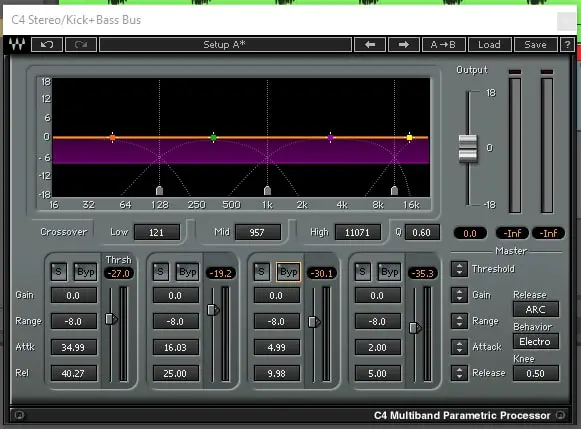
Multiband Compressor
With it, you are free to make the punch more punchier and the body more consistent. The punch of the low end generally resides in a little upper region of the frequency spectrum.
The area around 200 Hz is where the knock is the most prominent.
You can make the division between the sub part and the punch part with the crossovers in this compressor.
You can control the punchy region to have more attack and the sub region to have more sustain and a moderate attack.
In this way the multiband compressor will give you the best of both the worlds – the punch and a consistent body!
11. Saturate the low end
Another way to make the kick and bass come out more defined and fat is with the use of saturation. Saturation makes the kick and bass blend very well into a more cohesive sound.
It also increases the perceived loudness of the signal.
Saturation is an effect that is used to make any signal more vibrant and exciting by introducing harmonic content in the waveform.
Saturation consists of two effects – compression and distortion.
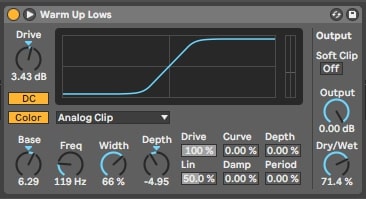
Low End Saturation
Distortion introduces harmonics in the original signal. Compression makes the signal even.
Saturation will provide more punch to the low end as it is basically a distortion.
It will make the peaks more edgy and sharp by slightly distorting them.
Saturation is an effect that should be used with care. A very little amount of saturation is enough for the sounds to get more exciting. If you take saturation above the limit, it surely is going to ruin the sound in an unpleasant way.
Conclusion
So, there you have it!
These are the best kick and bass mixing tips to make your low end most powerful and pleasing.
Following these tips will help you make your track sound professional.
Again as always, along with these tips, experiment more and find more methods to solve the problems in order to mature as a better producer!
Till then.. happy producing!
